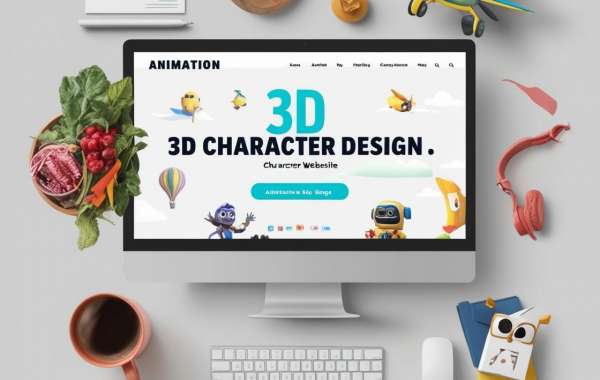Step 1: Conceptualization and Planning
Before the 3D character design process begins in software, a clear concept must be developed.
- Research and Inspiration: Gather reference materials, sketches, and photographs that align with the character’s appearance and personality.
- Sketching and Drawing: Create a rough 2D sketch of the character. This sketch can act as a blueprint for the character’s design, helping to visualize proportions, facial features, and general shapes.
- Defining Personality and Background: Outline the character’s traits, background story, and unique attributes. This can influence design choices and make the character more relatable.
Step 2: Modeling the Base Mesh
The base mesh is the foundation for 3D characters design and provides a structure that will later be refined.
- Choosing Software: Software such as Blender, Maya, or ZBrush is commonly used for 3D modeling. Each program has unique features for character creation.
- Blocking Out Basic Shapes: Begin by blocking out basic shapes and proportions using simple geometry. The head, torso, arms, and legs are shaped individually to establish proportions.
- Adjusting for Realistic Proportions: For a realistic character, follow human anatomy guidelines. This step ensures that the character looks natural in terms of height, weight, and posture.
- Creating a Base Mesh: A simple base mesh is sculpted without fine details. This stage focuses more on the character’s form and flow rather than intricate details.
Step 3: Sculpting and Detailing
After the base mesh is ready, 3D character artists proceed with adding details to bring the character to life.
- Refining Anatomy and Muscles: Sculpting tools help refine muscles, joints, and bone structures, especially in areas like the face, arms, and legs.
- Adding Surface Details: Use sculpting brushes to add texture, such as wrinkles, pores, and scars, depending on the character’s age and lifestyle.
- Creating Finer Details: Smaller details like fingernails, hairline, and eyelids give the character a more realistic look. ZBrush is a popular choice for this stage due to its advanced sculpting capabilities.
Step 4: Retopology and UV Mapping
Retopology is the process of creating a clean, low-polygon mesh from a high-polygon sculpt. This stage is essential to ensure smooth animation and optimize rendering.
- Reducing Poly Count: Convert the high-poly sculpt to a low-poly version that will be easier to animate and render.
- Creating Edge Loops: Edge loops are used around joints, eyes, and other areas that require movement. This structure helps maintain shape during animation.
- UV Mapping: UV mapping flattens the 3D model onto a 2D surface for texturing. Proper UV mapping is crucial to ensure textures are applied seamlessly on the character.
Step 5: Texturing and Shading
Once the character has been retopologized and UV-mapped, texturing begins. This stage adds color, texture, and material properties to the character’s surface.
- Creating Realistic Skin Textures: Skin textures add depth to the character. Substance Painter and Photoshop are commonly used to paint realistic skin details, freckles, scars, and other surface attributes.
- Using Subsurface Scattering: Subsurface scattering (SSS) is essential for rendering realistic skin. SSS simulates how light penetrates and scatters within the skin, creating a natural look.
- Adding Hair, Eyes, and Clothing Textures: Use high-resolution textures for elements like hair, eyes, and clothing. Hair can be created using particle systems or specialized hair tools within 3D software.
Step 6: Rigging and Skinning
Rigging adds a skeleton to the character, while skinning binds the mesh to the rig, allowing for realistic movement.
- Building the Skeleton: Create a skeletal structure with bones for the torso, limbs, and face. Each bone represents a part of the character’s anatomy that will move during animation.
- Adding Controls for Animation: Control rigs enable character animation design by adding controllers that allow animators to manipulate bones easily.
- Skinning: Attach the character’s mesh to the skeleton. Weight painting defines how much each bone influences the mesh, ensuring smooth bending at joints.
Step 7: Facial Rigging and Expression Setup
Facial rigging enables expressive movements, such as smiling, frowning, and talking.
- Blend Shapes for Expressions: Blend shapes are used to create different facial expressions, such as smiles or frowns, which animators can blend seamlessly during animation.
- Mouth and Eye Rigging: Adding rig controls for the mouth, eyelids, and eyebrows allows for finer control over facial expressions, essential for conveying emotions.
Step 8: Animating the Character
Once the rigging is complete, the character is ready for animation.
- Adding Keyframes: Keyframes define start and end points of movements. By setting keyframes, animators control movements over time, making the character walk, jump, or wave.
- Creating Natural Movements: Animators study real-life movements to recreate them accurately. Realism in animation often involves subtle shifts in weight, timing, and balance.
- Adding Facial Animation: Facial animations, such as blinking or speaking, bring the character to life and make interactions more engaging.
Step 9: Lighting and Rendering
Lighting is essential to enhance realism and bring out the best in your animation character 3D. The rendering process turns the 3D model into a finished image or video.
- Lighting Setup: Proper lighting enhances the character’s features. A three-point lighting setup with a key, fill, and backlight creates depth and highlights textures.
- Rendering Software: Render engines like Arnold, V-Ray, and Blender’s Cycles produce high-quality images that capture all the textures, colors, and lighting effects.
- Post-Processing: Use compositing software to add final touches, such as color correction or background elements.
Step 10: Final Adjustments and Presentation
Once the character is rendered, it may still need adjustments for presentation.
- Polishing Textures and Details: Minor tweaks, such as adjusting textures or fixing small lighting issues, can enhance the final image.
- Exporting for Different Platforms: Depending on the project, export settings might change. Game assets need to be optimized differently than assets for cinematic rendering.
- Reviewing and Testing: Test the character in its final environment to ensure that textures, rigging, and animations work as intended.
Essential Tools for 3D Character Design
- ZBrush: Known for its high-resolution sculpting tools, ZBrush is ideal for adding detailed textures.
- Blender: Blender is a versatile open-source tool that can handle modeling, texturing, rigging, and animation.
- Substance Painter: This tool is excellent for creating realistic textures for skin, clothing, and accessories.
- Maya: Maya is widely used for rigging and animation, providing robust tools for character movement.
- Arnold Renderer: A powerful rendering engine that captures realistic lighting, shadows, and textures.
Conclusion: Bringing It All Together
Creating a realistic 3D character design involves a step-by-step approach with a focus on each stage, from initial concept and modeling to rigging and final rendering. This process requires both technical and artistic skills, along with patience and attention to detail. For 3D character artists, mastering each step can lead to lifelike characters that resonate with audiences, whether in games, films, or other digital media. With the right tools and techniques, artists can achieve high-quality character animation design that stands out.




